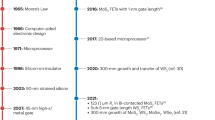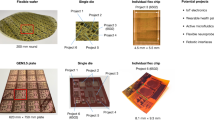Abstract
Microthermoelectric modules are of potential use in fields such as energy harvesting, thermal management, thermal imaging and high-spatial-resolution temperature sensing. In particular, microthermoelectric coolers (µ-TECs)—in which the application of an electric current cools the device—can be used to manage heat locally in microelectronic circuits. However, a cost-effective µ-TEC device that is compatible with the modern semiconductor fabrication industry has not yet been developed. Furthermore, the device performance of µ-TECs in terms of transient responses, cycling reliability and cooling stability has not been adequately assessed. Here we report the fabrication of µ-TECs that offer a rapid response time of 1 ms, reliability of up to 10 million cycles and a cooling stability of more than 1 month at constant electric current. The high cooling reliability and stability of our µ-TEC module can be attributed to a design of free-standing top contacts between the thermoelectric legs and metallic bridges, which reduces the thermomechanical stress in the devices.
This is a preview of subscription content, access via your institution
Access options




Similar content being viewed by others
Data availability
The data that support the plots within this paper and other findings of this study are available from the corresponding author upon reasonable request.
Change history
05 November 2018
In the version of this Article originally published, in the Methods section ‘Analytical calculation and FEM simulation’ the first equation was incorrect and has now been replaced. In addition, in the section ‘Conclusions’, the packing density mistakenly read ‘5,000 leg pairs per cm2’ and has now been corrected to read ‘5,500 leg pairs per cm2’.
References
Twaha, S., Zhu, J., Yan, Y. & Li, B. A comprehensive review of thermoelectric technology: materials, applications, modelling and performance improvement. Renew. Sustain. Energy Rev. 65, 698–726 (2016).
Yan, J., Liao, X., Yan, D. & Chen, Y. Review of micro thermoelectric generator. J. Microelectromech. Syst. 27, 1–18 (2018).
Venkatasubramanian, R., Siivola, E., Colpitts, T. & O’Quinn, B. Thin-film thermoelectric devices with high room-temperature figures of merit. Nature 413, 597–602 (2001).
Chowdhury, I. et al. On-chip cooling by superlattice-based thin-film thermoelectrics. Nat. Nanotech. 4, 235–238 (2009).
Watkins, C., Shen, B. & Venkatasubramanian, R. Low-grade-heat energy harvesting using superlattice thermoelectrics for applications in implantable medical devices and sensors. In Proc. ICT 2005, 24th Int. Conf. Thermoelectrics 265–267 (IEEE, 2005).
Yang, Y., Wei, X.-J. & Liu, J. Suitability of a thermoelectric power generator for implantable medical electronic devices. J. Phys. D 40, 5790–5800 (2007).
Lay-Ekuakille, A., Vendramin, G., Trotta, A. & Mazzotta, G. Thermoelectric generator design based on power from body heat for biomedical autonomous devices. In Proc. 2009 IEEE Int. Workshop Medical Meas. Appl., MeMeA 1–4 (IEEE, 2009); https://doi.org/10.1109/MEMEA.2009.5167942
Rojas, J. P. et al. Review—Micro and nano-engineering enabled new generation of thermoelectric generator devices and applications. ECS J. Solid State Sci. Technol. 6, N3036–N3044 (2017).
Leonov, V. & Vullers, R. J. M. Wearable electronics self-powered by using human body heat: the state of the art and the perspective. J. Renew. Sustain. Energy 1, 062701 (2009).
Kim, S. J., We, J. H. & Cho, B. J. A wearable thermoelectric generator fabricated on a glass fabric. Energy Environ. Sci. 7, 1959–1965 (2014).
Kishi, M. et al. Fabrication of a miniature thermoelectric module with elements composed of sintered Bi-Te compounds. In Proc. ICT’97, 16th Int. Conf. Thermoelectrics (cat. no. 97TH8291) 653–656 (IEEE, 1997); https://doi.org/10.1109/ICT.1997.667614
Fleurial, J.-P. et al. Thermoelectric microcoolers for thermal management applications. In Proc. ICT’97, 16th Int. Conf. Thermoelectrics (cat. no. 97TH8291) 641–645 (IEEE, 1997); https://doi.org/10.1109/ICT.1997.667611
Birkholz, U., Fettig, R. & Rosenzweig, J. Fast semiconductor thermoelectric devices. Sens. Actuat. 12, 179–184 (1987).
Böttner, H. et al. New thermoelectric components using microsystems technologies. J. Microelectromech. Syst. 13, 414–420 (2004).
Bahk, J. H., Fang, H., Yazawa, K. & Shakouri, A. Flexible thermoelectric materials and device optimization for wearable energy harvesting. J. Mater. Chem. C 3, 10362–10374 (2015).
Wendt, H. & Kreysa, G. Electrochemical Engineering: Science and Technology in Chemical and Other Industries (Springer, Berlin, Heidelberg, 1999).
Schumacher, C. et al. Optimization of electrodeposited p-doped Sb2Te3 thermoelectric films by millisecond potentiostatic pulses. Adv. Energy Mater. 2, 345–352 (2012).
Schumacher, C. et al. Optimizations of pulsed plated p- and n-type Bi2Te3-based ternary compounds by annealing in different ambient atmospheres. Adv. Energy Mater. 3, 95–104 (2013).
Snyder, G. J., Lim, J. R., Huang, C.-K. & Fleurial, J.-P. Thermoelectric microdevice fabricated by a MEMS-like electrochemical process. Nat. Mater. 2, 528–531 (2003).
Enright, R. et al. Electrodeposited micro thermoelectric module design for hybrid semiconductor laser cooling on a silicon photonics platform. Trans. Electrochem. Soc. 69, 37–51 (2015).
Medina-Sánchez, M. & Schmidt, O. G. Medical microbots need better imaging and control. Nature 545, 406–408 (2017).
Stordeur, M. & Stark, I. Low power thermoelectric generator — self-sufficient energy supply for micro systems. In Proc. ICT’97, 16th Int. Conf. Thermoelectrics (cat. no.97TH8291) 575–577 (IEEE, 1997); https://doi.org/10.1109/ICT.1997.667595
Fleurial, J. P. et al. Development of thick-film thermoelectric microcoolers using electrochemical deposition. In Thermoelectr. Mater. 1998 — Next Gener. Mater. Small-Scale Refrig. Power Gener. Appl. Vol. 545 (eds Tritt, T. M. et al.) 493–500 (1999).
da Silva, L. W. & Kaviany, M. Fabrication and measured performance of a first-generation microthermoelectric cooler. J. Microelectromech. Syst. 14, 1110–1117 (2005).
Lim, J. R. et al. Fabrication method for thermoelectric nanodevices. Adv. Mater. 17, 1488–1492 (2005).
Huang, I.-Y., Li, M.-J., Chen, K.-M., Zeng, G.-Y. & She, K.-D. Design and fabrication of a column-type microthermoelectric cooler with bismuth telluride and antimony telluride pillars by using electroplating and MEMS technology. In 2007 2nd IEEE Int. Conf. Nano/Micro Eng. Molecular Syst. 749–752 (IEEE, 2007); https://doi.org/10.1109/NEMS.2007.352126
Gross, A. J. et al. Multistage planar thermoelectric microcoolers. J. Microelectromech.Syst. 20, 1201–1210 (2011).
Kim, M.-Y. & Oh, T.-S. Thermoelectric thin film device of cross-plane configuration processed by electrodeposition and flip-chip bonding. Mater. Trans. 53, 2160–2165 (2012).
Roth, R. et al. Design and characterization of micro thermoelectric cross-plane generators with electroplated Bi2Te3, SbxTey, and reflow soldering. J. Microelectromech. Syst. 23, 961–971 (2014).
Zhang, W., Yang, J. & Xu, D. A high power density micro-thermoelectric generator fabricated by an integrated bottom-up approach. J. Microelectromech. Syst. 25, 744–749 (2016).
Trung, N. H., Van Toan, N. & Ono, T. Fabrication of π-type flexible thermoelectric generators using an electrochemical deposition method for thermal energy harvesting applications at room temperature. J. Micromech. Microeng. 27, 125006 (2017).
Yang, F., Zheng, S., Wang, H., Chu, W. & Dong, Y. A thin film thermoelectric device fabricated by a self-aligned shadow mask method. J. Micromech. Microeng. 27, 055005 (2017).
Lin, S. et al. Tellurium as a high-performance elemental thermoelectric. Nat. Commun. 7, 10287 (2016).
Younes, E., Christofferson, J., Maize, K. & Shakouri, A. Short time transient behavior of SiGe-based microrefrigerators. MRS Proc. 1166, 1166–N01-06 (2009).
He, R., Schierning, G. & Nielsch, K. Thermoelectric devices: a review of devices, architectures, and contact optimization. Adv. Mater. Technol. 2017, 1700256 (2017).
Garcia, J. et al. JSS focus issue on thermoelectric materials and devices fabrication and modeling of integrated micro-thermoelectric cooler by template-assisted electrochemical deposition. ECS J. Solid State Sci. Technol. 6, 3022–3021 (2017).
Snyder, G. J. & Toberer, E. S. Complex thermoelectric materials. Nat. Mater. 7, 105–114 (2008).
Muñoz-García, M. A., Moreda, G. P., Raga-Arroyo, M. P. & Marín-González, O. Water harvesting for young trees using Peltier modules powered by photovoltaic solar energy. Comput. Electron. Agric. 93, 60–67 (2013).
Rowe, D. M. in CRC Handbook of Thermoelectrics 1251–1256 (CRC, New York, 1995).
Perron, J. C. Thermal conductivity of selenium-tellurium liquid alloys. Phys. Lett. A 32, 169–170 (1970).
Nolas, G. S., Sharp, J. & Goldsmid, H. J. Thermoelectrics: Basic Principles and New Materials Developments (Springer, Berlin Heidelberg, 2001).
Acknowledgements
The authors thank T. Sieger, H. Stein, C. Kupka and R. Uhlemann in IFW Dresden for helpful technical support. G.L. thanks T. G. Woodcock in Leibniz IFW Dresden for his valuable comments and suggestions for this Article. G.L. and V.B acknowledge financial support from the European Union (EU) and the Free State of Saxony through the European Regional Development Fund (ERDF) (SAB GroTEGx, grant no. 100245375). J.G.F. acknowledges financial support from the EU’s Horizon 2020 research and innovation program (H2020 RIA Tips, grant no. 644453), D.A.L.R. acknowledges funding from the Mexican National Council for Science and Technology (grant no. CVU611106).
Author information
Authors and Affiliations
Contributions
G.L., J.G.F., H.R., G.S. and K.N. designed the work. G.L. and J.G.F. fabricated the integrated microcoolers and carried out the device performance characterization. J.G., D.A.L.R. and V.B. performed the model simulation based on FEM COMSOL and analytical calculations. G.L. and N.P. performed the scanning electron microscope observations. G.L. and I.S. carried out the temperature-dependent cooling performance measurements. G.L. wrote the manuscript, with input from all authors.
Corresponding author
Ethics declarations
Competing interests
The authors declare no competing interests.
Additional information
Publisher’s note: Springer Nature remains neutral with regard to jurisdictional claims in published maps and institutional affiliations.
Supplementary information
Supplementary Information
Supplementary Notes, Supplementary Figures 1–5 and Supplementary Table 1
Supplementary Video 1
Video of water condensation on microthermoelectric coolers when the stage temperature is set at 280 K
Rights and permissions
About this article
Cite this article
Li, G., Garcia Fernandez, J., Lara Ramos, D.A. et al. Integrated microthermoelectric coolers with rapid response time and high device reliability. Nat Electron 1, 555–561 (2018). https://doi.org/10.1038/s41928-018-0148-3
Received:
Accepted:
Published:
Issue Date:
DOI: https://doi.org/10.1038/s41928-018-0148-3
This article is cited by
-
On-Chip Micro Temperature Controllers Based on Freestanding Thermoelectric Nano Films for Low-Power Electronics
Nano-Micro Letters (2024)
-
Evoking natural thermal perceptions using a thin-film thermoelectric device with high cooling power density and speed
Nature Biomedical Engineering (2023)
-
Techniques to help devices keep their cool
Nature Electronics (2022)
-
Micro-thermoelectric devices
Nature Electronics (2022)
-
A Strategy to Reduce the Peak Temperature of the Chip Working under Dynamic Power Using the Transient Cooling Effect of the Thin-Film Thermoelectric Cooler
Journal of Thermal Science (2022)



